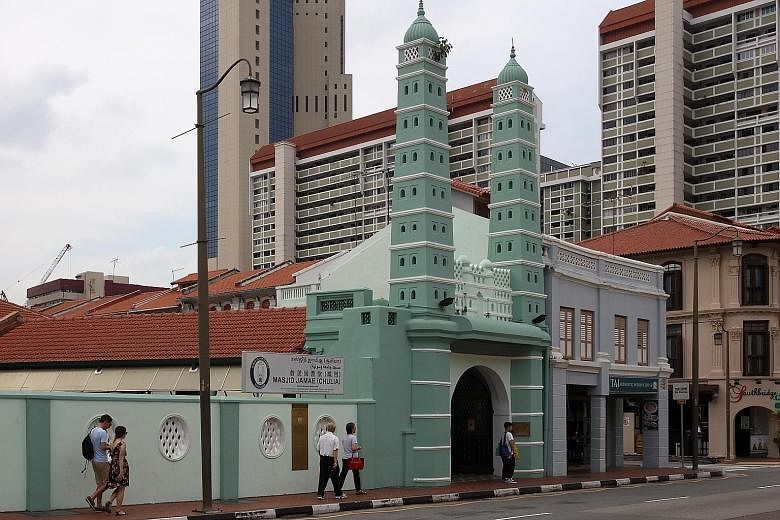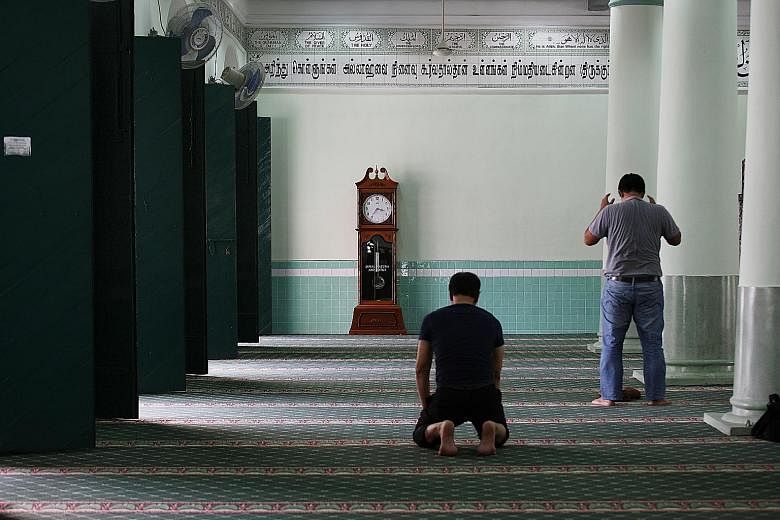In a little shrine tucked away in Jamae Mosque, the wall clock ticks away, telling the time.
But the room's occupant takes no heed.
A colourful blanket drapes over the tomb of prominent local Tamil Muslim religious leader Muhammad Salih Valiullah. The tomb has been there even before the 1830s.
The mosque's management board chairman, Mr Shaick Fakrudeen, said the shrine serves as a place where worshippers can pray for Muhammad Salih Valiullah, and reflect on the fact that they too will pass on one day.
This is but one of the many unique features of Jamae Mosque, which has been central to the Tamil Muslim community in the Chinatown and greater Tanjong Pagar region since it was established in 1826.

While the outside world knows it as Jamae Mosque or Masjid Jamae, its congregants call it Periya Palli (Tamil for "Big Mosque") or Chulia Palli (Tamil for "Chulia Mosque").
The Chulias, for whom the street in Raffles Place is named, were mainly Tamil Muslims from India's south-eastern coast and mostly moneylenders or traders.
Until the 1950s the mosque also bore the name Paalkaara Kadai Palli, which means "Milkman's Shop Mosque". There are several possible reasons for this, one being that a large number of Tamils used to milk their cows in the street adjacent to the compound.
The various names bestowed upon it by its worshippers point to the fact that Tamil is the main tongue used in Jamae Mosque, and that it is in fact one of the six mosques in Singapore that regularly conduct sermons in Tamil.
Monthly Islamic talks are held in the south Indian tongue, as are most Friday sermons, except on the second Friday of every month, when they are held in English and Malay. Religious classes are also taught in Tamil and English.
The common language no doubt contributes to the strong sense of community that keeps its members coming back for decades. There are about 90,000 Tamil Muslims in Singapore today, said Mr Shaick.
Retiree Mohamed Farouk Ahmad Sha has worshipped at Jamae Mosque since he was born 58 years ago in nearby Tanjong Pagar. Though he moved away in 1965, he still goes there to pray each week.
The former hardware store vendor said he most likes that he can speak Tamil in Jamae Mosque. "Even in my wheelchair I come here," said Mr Mohamed Farouk, who is diabetic. "I cannot forget this place... I love this mosque very much."
As one of Singapore's oldest mosques, its role in the Tamil Muslim community stretches back almost two centuries.
During colonial times it even functioned as a central post collection point for the local Muslim community. Those who lacked proper addresses would simply give the mosque's location for their mail, and would collect it from there once it arrived.
The mosque took its current form in 1835, and aside from repair works, its structure has remained more or less unchanged since. It was designed by Irish architect George Coleman, and is an eclectic blend of Indian and European form.
The front gate is flanked by two octagonal minarets, and has long served as a landmark for South Bridge Road, while Tuscan columns line the interior.
It is one of three majority-Tamil mosques that are national monuments.
Interestingly, although the mosque's compound and gate align with the urban planning grid, the buildings inside are oriented to face towards Mecca.
We may know it today as a pale green house of worship, but up until the early 1990s it had a white-beige hue. Green was chosen as its new shade because of the colour's significance in Islam, said Mr Shaick.
It is understood to be one of Prophet Muhammad's most beloved colours.
Thanks to its central Chinatown location, tourists and visitors throng the streets just outside the compound.
Jamae Mosque took advantage of this early on to open its doors and reach out to those who may be curious about the Islamic faith.
Since 2002, its dawah officer (dawah is Arabic for "invite") has given daily guided tours of the mosque.
Interested visitors can sign up online, and hundreds of non-Muslims pass through its gates every day, whether for a tour or to simply peek inside and read the informational guides the mosque set up in 2002.
Even the shrine, which appears to be hidden behind the main building, is open to the public during opening hours.
Ustaz Haniff Sultan has worked at Jamae Mosque as its dawah officer since 2009, and, by his own count, said he has given guided tours to about 50,000 people so far - which he says is a conservative estimate.
He is proud that the mosque plays this educational role, and when asked for his most memorable guiding experience, smiled and said: "I have many."
When pushed further, Mr Haniff, 36, recalled spending three hours showing a teenage Argentinian couple around the premises and answering their questions. They had never been in a mosque before, and he was happy to host them.
Today, Jamae Mosque's congregation is more mixed, thanks to its proximity to offices in the neighbourhood.
But just like how it served a Tamil community that had ventured far from their homeland, so it draws immigrants today.
In a quiet moment, Mr Shaick sat and remembered his journey to Singapore in 1994 from Chennai, the capital of Tamil Nadu, India.
The 49-year-old accountant used to work nearby, and said he loves the mosque because of its history, and its sense of community that makes it feel like a kampung.
It played a big part in his life when he was still new to this country. "This was the first mosque I worshipped in for Friday prayers in Singapore," he said.




